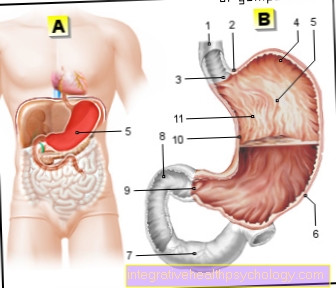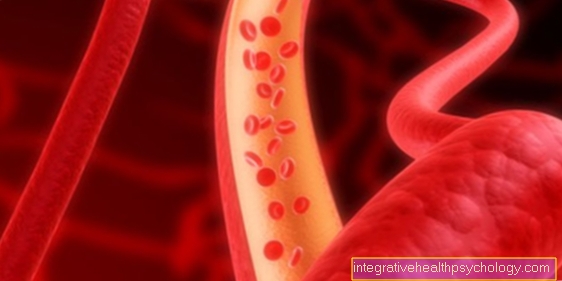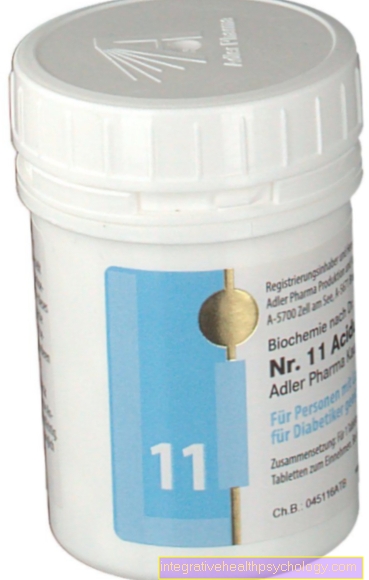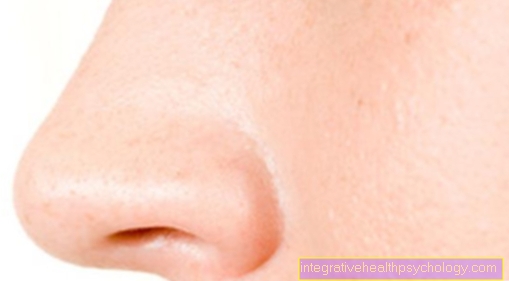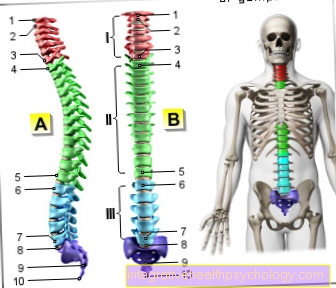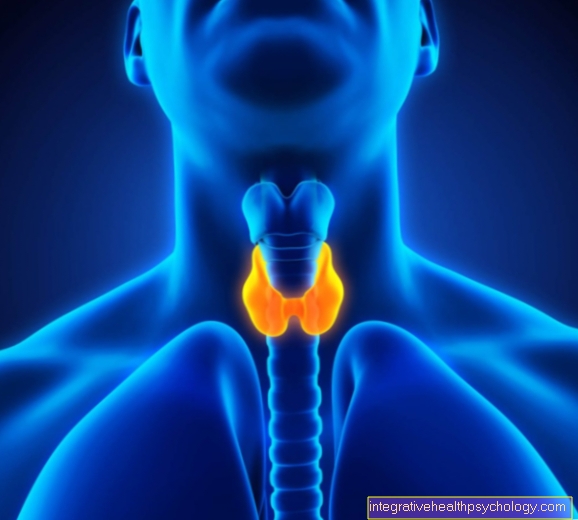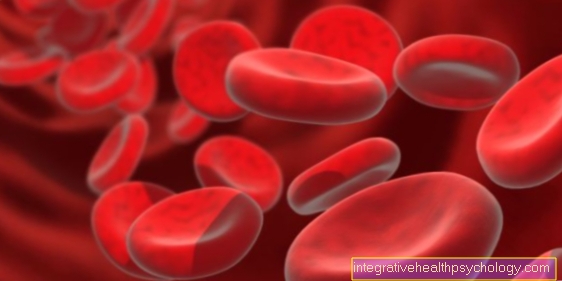Muscle relaxants
What are muscle relaxants?
Muscle relaxants are special drugs that relax muscle cells. This effect is used in particular in anesthesia to induce anesthesia. Muscle relaxation is also of great importance for the ventilation of a patient during an operation. In addition, muscle relaxants can be used to loosen tense muscles in the neck or back area.
There are two groups of muscle relaxants - peripheral and central muscle relaxants. They differ in their place of activity. Peripheral muscle relaxants act directly on the muscles, whereas the central muscle relaxants develop their effect in the central nervous system, where they reduce muscle tone.

These muscle relaxers are there
Muscle relaxants are basically divided into two main groups. On the one hand there are the peripheral muscle relaxants, which act directly on the muscle or the transmission between nerve and muscle. The central muscle relaxants, which work in the central nervous system, i.e. the brain and spinal cord, differ from this. They are intended to reduce the basic tension in the muscles and thus relieve cramps.
Tense muscles are often a symptom or cause of back pain, as almost everyone knows. Centrally acting muscle relaxants are mostly used here. They are less powerful in their effect and rather regulate the tension in the muscles.
In contrast, peripherally acting muscle relaxants are used primarily in anesthesia and surgery. These act directly on the muscles and, with sufficient doses, can cause complete flaccid but temporary paralysis. In particular, peripheral muscle relaxants can be divided into further subgroups according to their exact mechanisms of action.
The benzodiazepines
The benzodiazepines, actually known as sleeping pills or sedatives, also act as muscle relaxants. The reason for this lies in their mechanism of action. They act on so-called GABA receptors in the central nervous system. In the brain, GABA is a so-called inhibitory, i.e. inhibiting, neurotransmitter. Under the action of benzodiazepines, GABA is increased in its effect.
The result is drowsiness, anxiety relief, but also muscle relaxation. The muscle-relaxing effect is reinforced by a general release of anxiety or relaxation, as the muscles are involuntarily tensed when anxious or excited.
Benzodiazepines, however, are not free from side effects. A major danger in taking benzodiazepines is their addiction potential. Benzodiazepines can easily trigger an addiction and even cause withdrawal symptoms if they are discontinued. This is especially true for permanent use. A dependency can already exist after weeks.
Read more about this under: Benzodiazepines
The Ortoton
Ortoton is the trade name of the active ingredient methocarbamol. This is also a centrally acting muscle relaxant. Its mechanism of action differs from that of benzodiazepines. It works directly in the spinal cord. There it presumably inhibits reflex lines.
If these reflex lines are active, the tension in the muscles increases. If they are inhibited by methocarbamol, it decreases. However, the exact mechanism of action is not yet fully understood. Proof of the effectiveness of methocarbamol has not yet been conclusively given.
One advantage of methocarbamol is that it causes less fatigue than benzodiazepines, for example. Due to its central mechanism of action, the strength of the muscles is not noticeably affected. The coordination doesn't seem to be affected either.
Unwanted effects are rather rare. However, methocarbamol in higher doses can have a depressant effect and possibly even cause addiction. However, the risk is lower compared to benzodiazepines. At the same time, there are critical voices who question the effectiveness of methocarbamol for tension.
The Sirdalud
The active ingredient contained in Sirdalud is called tizanidine. It also works in the central nervous system. Here it attacks so-called α2 adrenoceptors. This also causes a decrease in muscle tension. Adrenoceptors not only control muscle tension, but also important body functions, such as blood pressure.
An important side effect of tizanidine is therefore the so-called orthostatic dysregulation. The body is no longer able to effectively adjust blood pressure to changing circumstances, such as changing from lying down to standing. This manifests itself as a drop in blood pressure.
In the worst case, this can lead to fainting. Other important undesirable effects of tizanidine are fatigue and dry mouth. Tizanidine may also have an analgesic effect. However, this can be beneficial for severe muscle tension.
A great advantage of tizanidine is that its dependence potential is significantly lower than with comparable drugs such as benzodiazepines. However, if tizanidine is suddenly stopped, palpitations or high blood pressure can occur.
This is especially the case if tizanidine has been taken for a long time or in high doses. Therefore, caution is required, especially with known heart diseases.
These muscle relaxants are available over the counter
Not all products sold as muscle relaxants require a prescription. Rather, a large number of agents with an antispasmodic effect are offered without a prescription. Usually these are plant-based preparations. These include, for example, rosemary, valerian, lavender or horseradish. However, whether and how such preparations work has usually not been clarified.
A herbal origin of preparations does not guarantee that they are free from side effects. Magnesium is also often used to relax muscles. Here too, studies are often imprecise or contradicting. The great advantage of magnesium, however, is its low side effects and the low price, so that little contradicts attempting treatment.
Read more about this topic here: The magnesium.
The indication
The indication of muscle relaxants differs depending on the group of muscle relaxants. Peripheral muscle relaxants are used for endotracheal intubation. With endotracheal intubation, a hollow probe is inserted through the mouth and advanced further until the probe is in the airways. Artificial ventilation can thereby be guaranteed. However, to make intubation easier and to minimize the risk of injury, the patient is given a muscle relaxant. The muscles relax and the tube (hollow probe) can be inserted with a better view.
Another indication for the use of peripheral muscle relaxants is open or minimally invasive surgery. Relaxing the muscles lowers the risk of complications because there is no defensive movement. It also improves vision and makes the operation easier for the surgeon.
Central muscle relaxants are used for muscle tension. They work directly in the brain and spinal cord and reduce muscle tone. This can be used for neurological diseases such as multiple sclerosis. But patients who suffer from painful tension in the back muscles can also benefit from relaxation.
Methocarbamol can also be used for a herniated disc, for example, to improve symptoms and increase mobility. However, it should be ruled out beforehand that permanent damage is caused by the herniated disc - in this case one would rather proceed surgically.
Also read the article: Back Pain - What Can You Do?
The effect
The effect of muscle relaxants also differs depending on the group of muscle relaxants. The peripheral muscle relaxants act on the skeletal muscles. Skeletal muscles are the muscles that can be moved at will - such as lifting an arm.
The peripheral muscle relaxants can in turn be divided into two classes. There are peripheral muscle relaxants that have a depolarizing effect. To do this, the drug binds to receptors on the motor endplate, a contact point between a motor neuron and a muscle cell. The binding triggers a contraction, a depolarization, of the muscle cell. However, since the drug cannot be broken down by the enzymes, the muscle cells cannot be excited and the cell becomes slack. The best known depolarizing drug is succinylcholine. It is also the only drug in this class that is still used in human medicine. Succinylcholine takes effect very quickly, in about 40-60 seconds, and works for about 5-10 minutes.
In addition to the depolarizing muscle relaxants, non-depolarizing muscle relaxants are also present. They take effect within 2 - 5 minutes and can be reversed with special medication (e.g. neostigmine). They also bind to receptors on the motor endplate, but do not lead to depolarization. Well-known depolarizing muscle relaxants are the mivacurium, rocuronium and atracurium.
Centrally effective muscle relaxants develop their effect in the brain and spinal cord. There are different classes - not all central muscle relaxants act on the same nerve cells or by the same mechanism. Most, however, have a dampening effect on the brain, so that the muscle tone is reduced. Some drugs, such as tizanidine, can also bind directly to receptors in the spinal cord and relieve muscle tension there.
The side effect
Depolarizing muscle relaxants, especially succinylcholine, can lead to muscle cell breakdown. In extreme cases, rhabdomyolysis can be triggered. Rhabdomyolysis describes a breakdown of the muscles with the release of muscle proteins and other components. This can lead to various complications, in extreme cases kidney failure can result. In addition, electrolyte disturbances and consequently cardiac arrhythmias can also be caused. In addition, succinylcholine is a trigger substance for malignant hyperthermia. Malignant hyperthermia is a dreaded complication in anesthesia. Cardiac arrhythmia, an increase in body temperature and other organ damage occur. Because of these side effects, succinylcholine is rarely used.
Non-depolarizing muscle relaxants can lead to apnea or respiratory paralysis. Some drugs in this class, such as Pancuronium, can cause cardiac arrhythmias. Mivacurium, on the other hand, can lead to the release of histamine or even anaphylactic reactions.
Centrally effective muscle relaxants have different side effects depending on the drug. However, most drugs are tiring because of their inhibitory effects on the nervous system. They can also affect concentration and coordination.
With methocarbamol, however, this effect seems to be less pronounced. Tizanidine is known to cause blood pressure problems. Especially when changing from lying down to standing or when suddenly exerting yourself, blood pressure can drop. There is a potential for addiction to some muscle relaxants. Benzodiazepines in particular are affected by this. Other typical side effects of muscle relaxants are mainly unspecific complaints such as dizziness, headaches or nausea.
Find out more about the possible ones here Complications in anesthesia.
The interaction
Due to the large number of different muscle relaxants, different interactions are possible. Most centrally acting muscle relaxants increase the effects of other drugs that have a depressant effect on the nervous system.
These include certain pain relievers such as opiates, but also sleeping pills or antidepressants. The effect of pyridostigmine, on the other hand, is weakened by methocarbamol.
Tizanidine interacts with a variety of substances. These include, above all, active ingredients that have an influence on blood pressure, such as beta blockers or ACE inhibitors. If in doubt, a doctor or pharmacist should always be asked. There are also a large number of databases on the Internet to check interactions.
Contraindications - When should muscle relaxants not be given?
In general, muscle relaxants should not be given if an intolerance to the active ingredient is known. These include allergies, but also other, unspecific reactions.
In the case of disorders of the liver and kidney function or certain diseases such as myasthenia gravis, the dosage of certain muscle relaxants should be adjusted or not taken.
Pregnancy or breastfeeding can be a reason not to take muscle relaxants. If in doubt, a doctor or pharmacist should always be asked.
The dosage
Muscle relaxants also differ in their dosage depending on the active ingredient. Usually standard dosages are used, which have been found in tests and studies to be a good balance of potency and side effects. For example, methocarbamol is taken three times a day.
In special cases, the doctor can also prescribe higher or lower dosages. The dosage can increase to up to ten tablets per day. One tablet contains 750 mg of active ingredient. Some muscle relaxants can also be given as an injection, that is, by syringe.
Muscle relaxants are usually taken for several days. Long-term use is generally not recommended.
The price
Muscle relaxants are offered at different prices. However, most of them require a prescription. In particular, stronger drugs such as benzodiazepines are not recommended for self-medication and are therefore not available over the counter.
Over-the-counter means for muscle relaxation are, for example, magnesium or various herbal supplements. Magnesium is relatively inexpensive and is available from less than five euros. Herbal supplements can also be more expensive.
The alternatives
Medication does not always have to be taken for tense muscles. First of all, it should be clarified whether the pain is a harmless tension or a symptom of a serious illness. Above all, frequent or unusual, severe pain can be a symptom of a dangerous illness.
In case of doubt, a doctor should be consolidated. If it is certain that the tension is harmless, there are a variety of possible therapies. These include, above all, various massages, warmth or movement. Above all, as a preventive measure, sufficient physical activity and avoidance of one-sided stress are decisive.
Peripheral muscle relaxants such as those used in surgery are indispensable there, so that there are hardly any alternatives.
Muscle relaxants and alcohol - are they compatible?
Alcohol can affect the way drugs work and metabolize in a number of ways.Muscle relaxants are also affected. Particular caution is required with centrally acting muscle relaxants such as benzodiazepines or methocarbamol.
Benzodiazepines in particular can have strong interactions with alcohol. The combination is life-threatening. Alcohol can also interfere with the breakdown of muscle relaxants. A combination of alcohol with muscle relaxants is therefore generally not recommended.
Can it be taken during pregnancy and breastfeeding?
For most muscle relaxants, the recommendation is to avoid taking them during pregnancy or breastfeeding. Benzodiazepines can harm the unborn child and should therefore not be used during pregnancy.
It is also not recommended to take methocarbamol or tizanidine. If in doubt, refer to the instruction leaflet. A doctor or pharmacist should also be consulted.
The effectiveness of the pill
Muscle relaxants can affect the effectiveness of the pill. Benzodiazepines in particular affect the liver so that other drugs, such as the pill, are broken down more quickly.
It is different with tizanidine. Here, taking certain contraceptives inhibits the breakdown of the active ingredient tizanidine. This can increase the effect of tizanidine when taking tizanidine and the pill at the same time. This can lead to an increased occurrence of undesirable effects.
The following article may also be of interest to you: Which drugs affect the effect of the pill?



